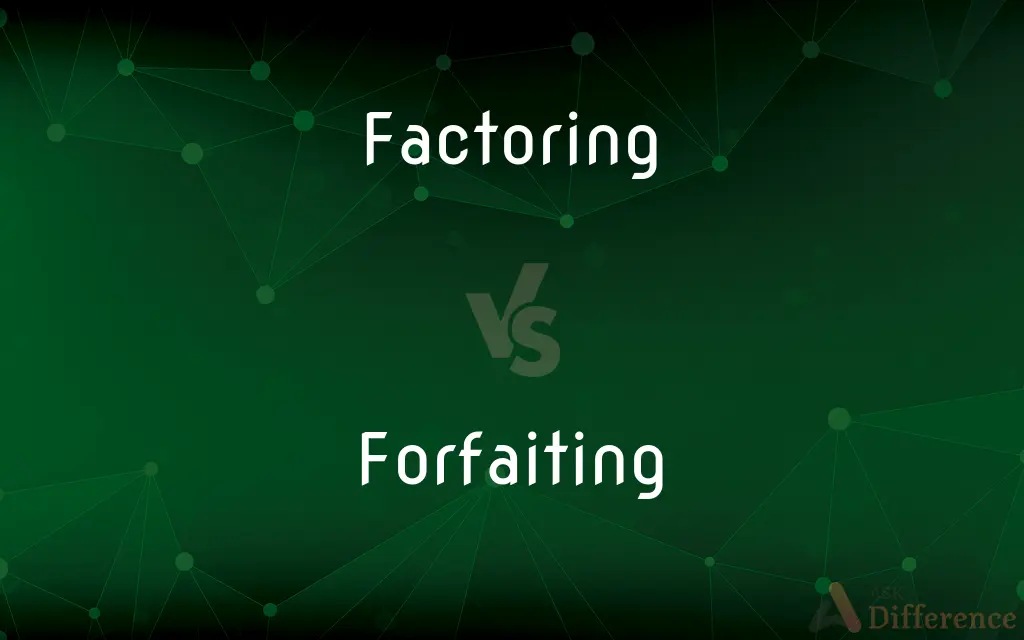Factoring vs. Forfaiting — What's the Difference?
By Urooj Arif & Fiza Rafique — Updated on March 20, 2024
Factoring involves a business selling its invoices to a third party to improve cash flow, whereas forfaiting is a financing method where exporters sell their long-term receivables for cash.

Difference Between Factoring and Forfaiting
Table of Contents
ADVERTISEMENT
Key Differences
Factoring is a financial transaction where a business sells its accounts receivable (invoices) to a third party (factor) at a discount. This process helps businesses improve their cash flow by receiving immediate payment for invoices instead of waiting for their customers to pay. Factoring is typically used for short-term receivables and involves the factor managing the sales ledger and collecting debts on behalf of the business.
Forfaiting, on the other hand, is a form of trade finance that involves the sale of an exporter's receivables to a forfaiter at a discount in exchange for immediate cash. This method is used primarily for international trade transactions and focuses on medium to long-term receivables. Unlike factoring, forfaiting typically deals with larger transactions and involves the sale of entire contracts or bills of exchange, removing the credit risk from the exporter.
While factoring is generally recourse-based, meaning the seller remains liable if the debtor fails to pay, forfaiting is usually non-recourse, transferring the credit risk to the forfaiter. This distinction makes forfaiting particularly attractive to exporters who wish to eliminate the risk of non-payment by foreign buyers.
Factoring is more common in domestic transactions and involves ongoing relationships between the business, its clients, and the factor. It is suitable for companies looking to manage cash flow more effectively. Forfaiting, with its focus on international trade, helps exporters finance large deals without assuming the risk of non-payment, making it an essential tool for businesses operating globally.
The choice between factoring and forfaiting depends on the nature of the business's receivables, the level of risk they are willing to retain, and whether their transactions are domestic or international. Both methods provide businesses with the flexibility to finance their operations without traditional loans, but each serves different financial needs and transaction structures.
ADVERTISEMENT
Comparison Chart
Focus
Short-term receivables
Medium to long-term receivables
Transaction Size
Typically smaller transactions
Larger, often related to international trade
Recourse
Often with recourse
Usually non-recourse
Risk Management
Seller may remain liable for unpaid debts
Credit risk is transferred to the forfaiter
Use
Improving cash flow, managing receivables
Financing larger international transactions
Relationship
Involves managing the sales ledger
Involves the sale of entire contracts
Compare with Definitions
Factoring
Typically involves recourse, where the seller might buy back unpaid invoices.
In their factoring agreement, the business was responsible for any invoices the factor couldn't collect on.
Forfaiting
A financing method where exporters sell their receivables at a discount for cash.
The manufacturer used forfaiting to eliminate the risk of non-payment by the overseas buyer.
Factoring
The sale of accounts receivable to a third party to improve cash flow.
To cover immediate operational costs, the company opted for factoring its outstanding invoices.
Forfaiting
Involves the non-recourse sale of future payment obligations.
By choosing forfaiting, the company transferred all credit risk to the forfaiter.
Factoring
Focuses on improving liquidity by turning receivables into immediate cash.
Factoring provided the liquidity needed to fund the company's rapid growth.
Forfaiting
Removes political, transfer, and commercial risks from the exporter.
Forfaiting ensured the exporter was insulated from the political instability of the buyer's country.
Factoring
Common in domestic transactions and with small to medium-sized businesses.
Many SMEs use factoring as a tool to manage cash flow more efficiently.
Forfaiting
Typically used in international trade to finance larger transactions.
Forfaiting facilitated the financing of a multimillion-dollar export deal without impacting the exporter's balance sheet.
Factoring
A financial transaction involving the management of receivables by a factor.
Factoring enabled the small business to delegate its debt collection efforts.
Forfaiting
Suited for transactions requiring long-term payment deferrals.
The construction equipment exporter opted for forfaiting to secure immediate payment for machinery sold on deferred payment terms.
Factoring
One that actively contributes to an accomplishment, result, or process
"Surprise is the greatest factor in war" (Tom Clancy).
Forfaiting
In trade finance, forfaiting is a service providing medium-term financial support for export/import of capital goods. The third party providing the support is termed the forfaiter.
Factoring
One who acts for someone else; an agent.
Factoring
One who purchases accounts receivable at a discount.
Factoring
(Mathematics) One of two or more quantities that divides a given quantity without a remainder. For example, 2 and 3 are factors of 6; a and b are factors of ab.
Factoring
A quantity by which a stated quantity is multiplied or divided, so as to indicate an increase or decrease in a measurement
The rate increased by a factor of ten.
Factoring
A gene. No longer in technical usage.
Factoring
(Physiology) A substance that functions in a specific biochemical reaction or bodily process, such as blood coagulation.
Factoring
To determine or indicate explicitly the factors of
If you factor 70, you get 2, 5, and 7.
Factoring
To engage in purchasing accounts receivable at a discount.
Factoring
A financial transaction whereby a business sells its accounts receivable to a third party (called a factor) at a discount.
Factoring
(math) The process of factorization.
Factoring
Present participle of factor
Factoring
The act of resolving into factors.
Factoring
(mathematics) the resolution of an integer or polynomial into factors such that when multiplied together they give the integer or polynomial
Common Curiosities
Do both factoring and forfaiting require the seller to give up control over their receivables?
Yes, both involve selling receivables, but factoring often includes ledger management, whereas forfaiting involves selling whole contracts.
Is forfaiting a risk-free financing option for exporters?
Forfaiting significantly reduces the risk of non-payment for exporters by transferring it to the forfaiter, but it's important to consider the cost and terms of the forfaiting agreement.
What is the main difference between factoring and forfaiting?
The main difference lies in the focus: factoring is for short-term receivables with possible recourse, while forfaiting deals with medium to long-term receivables on a non-recourse basis.
Can factoring improve a company's creditworthiness?
By improving cash flow and ensuring more consistent revenue, factoring can indirectly enhance a company's credit profile.
Can factoring and forfaiting be used for domestic and international transactions?
Factoring is commonly used for domestic transactions, whereas forfaiting is primarily used for international trade.
How do businesses choose between factoring and forfaiting?
Businesses consider the size and term of their receivables, their risk tolerance, and whether their transactions are domestic or international.
Why might a company prefer forfaiting to a traditional loan?
Companies may prefer forfaiting to avoid debt on their balance sheets and to eliminate the risk of non-payment by foreign buyers.
What risks does forfaiting mitigate for the seller?
Forfaiting mitigates commercial, political, and transfer risks associated with international trade.
What types of companies typically use factoring?
Small to medium-sized enterprises (SMEs) across various industries use factoring to manage cash flow and receivables.
How does the cost of factoring compare to forfaiting?
The cost can vary widely; factoring fees are generally based on invoice amounts and collection periods, while forfaiting costs depend on the credit risk and term of the receivables.
Share Your Discovery

Previous Comparison
Dynamic vs. Pattern
Next Comparison
Ordinary vs. SpecialAuthor Spotlight
Written by
Urooj ArifUrooj is a skilled content writer at Ask Difference, known for her exceptional ability to simplify complex topics into engaging and informative content. With a passion for research and a flair for clear, concise writing, she consistently delivers articles that resonate with our diverse audience.
Co-written by
Fiza RafiqueFiza Rafique is a skilled content writer at AskDifference.com, where she meticulously refines and enhances written pieces. Drawing from her vast editorial expertise, Fiza ensures clarity, accuracy, and precision in every article. Passionate about language, she continually seeks to elevate the quality of content for readers worldwide.














































